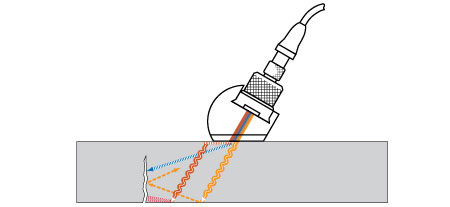Ultrasonic Flaw Detection Tutorial
9.2 CDS/Creeping Waves
CDS wedges are specialized plastic wedges used for crack detection and quick determination of whether a crack is ID connected. This technique can further indicate if the crack is located in the inner, middle or outer third of the part thickness. CDS stands for Creeping-Direct-Shear, also known as the 30-30-70 technique. CDS wedges use single element transducers to simultaneously generate three waves in the test piece.

- An OD creeping wave creates a 31.5 degree indirect shear wave (red path in drawing above), which mode converts to an ID creeping wave. This will produce a reflected signal from all ID connected cracks.
- A 30 degree shear wave (orange path) will reflect off the material ID at the critical angle to create a 70 degree longitudinal wave. A signal will be received by the transducer from cracks that extend into the midwall region or deeper.
- A 70 degree direct longitudinal wave (blue path) that will create a tip diffraction signal from very deep cracks.
The presence or absence of these signals are the key to interpreting test results. For a detailed discussion of typical test setup and interpretation, see Detection and Sizing Techniques of ID Connected Cracking.
죄송합니다. 이 페이지는 해당 국가에서 사용할 수 없습니다.
아래 양식을 작성하여 원하는 내용을 알려주십시오.